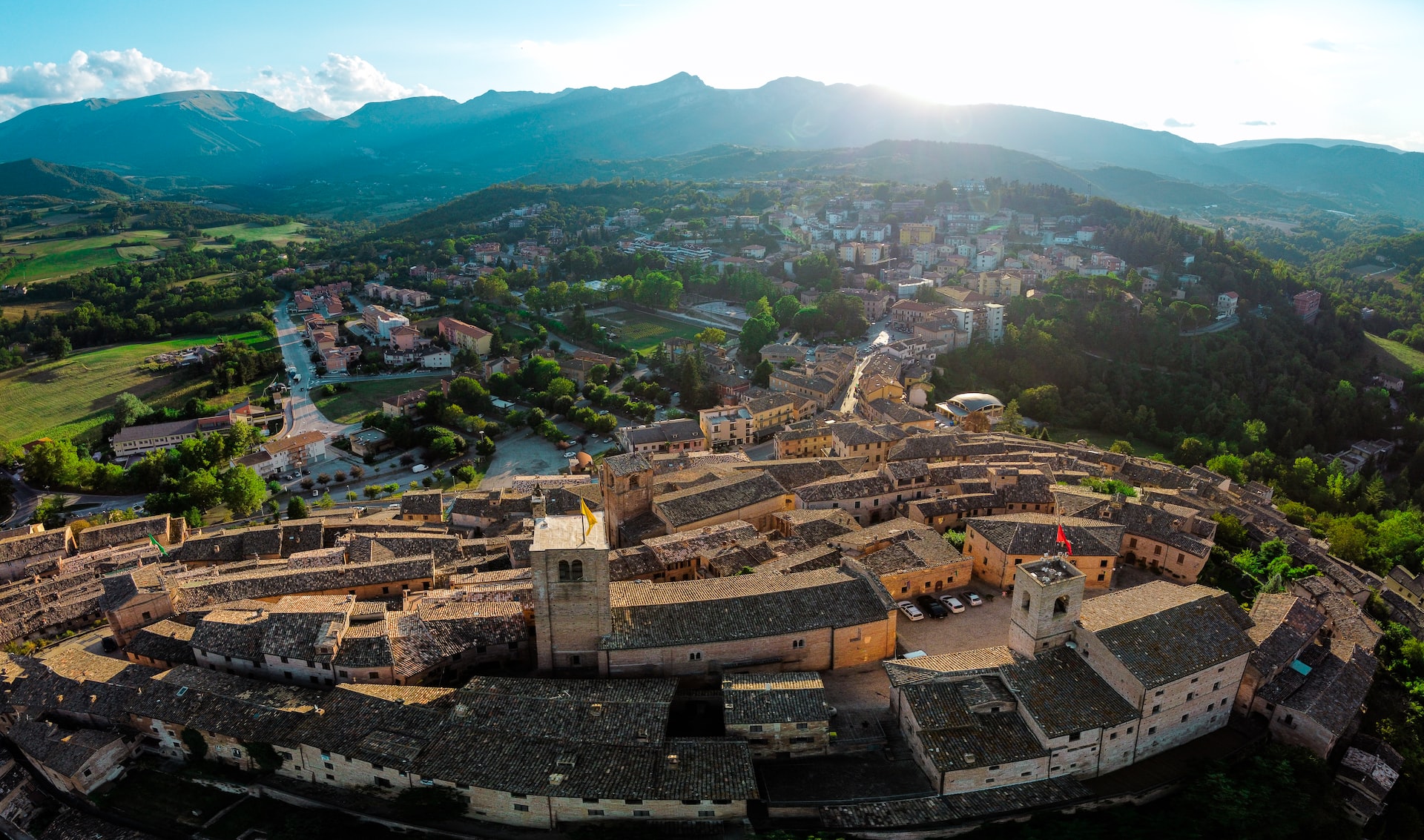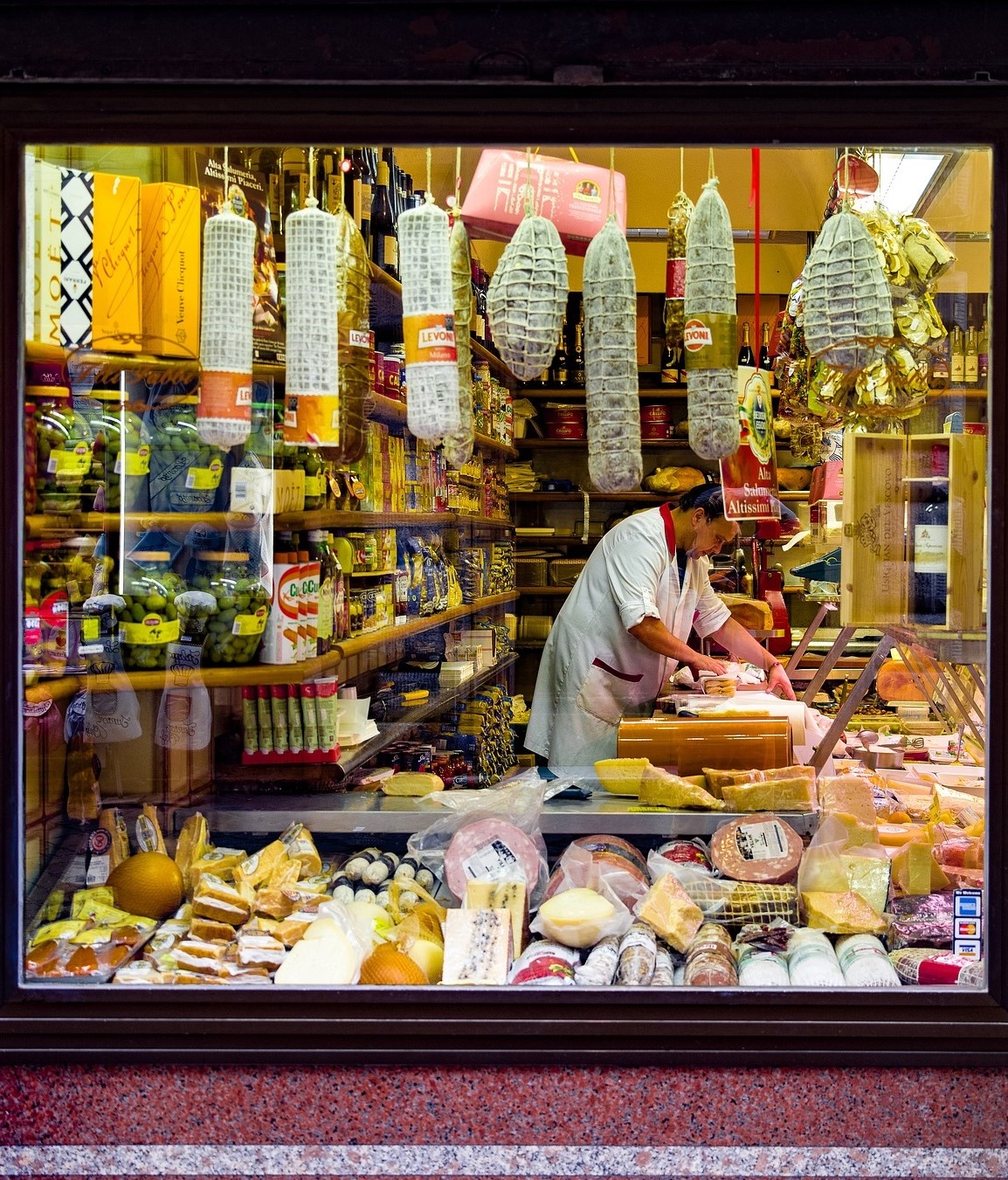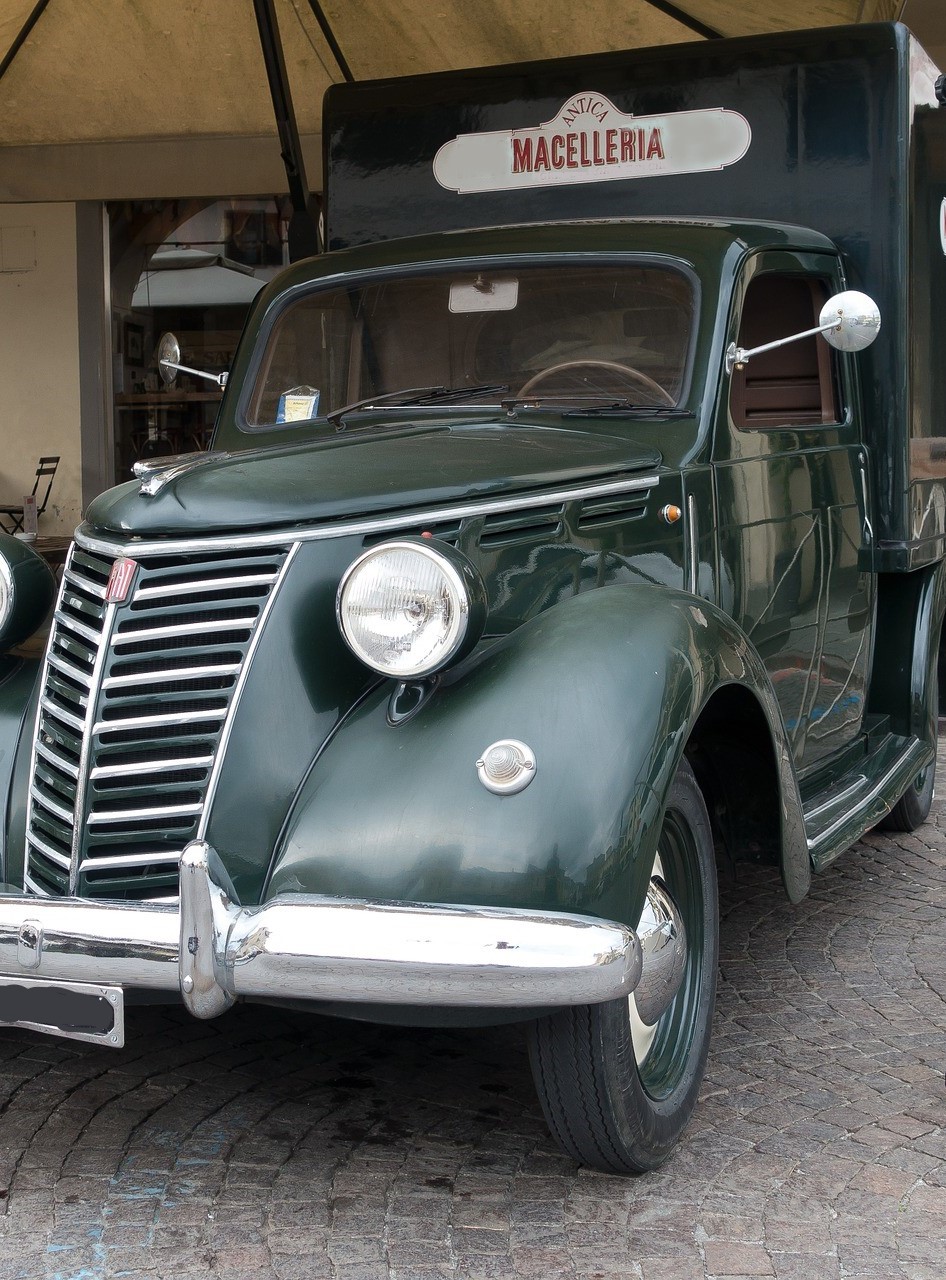- HOME
- Italian Stories and Albums
- An Italian Butcher
You come to Italy thinking it will be a trip. You leave knowing it was a beginning
Village Life in Italy
We Meet the Butcher and his Wife
Article shared with us by David Gerstel. A New York Times published writer who now spends the good part of his year in Italy.
The town I live in is Sarnano, four hours and a bit at speed by road north east of Rome in the province of Le Marche, the far reaches of an earlier time. Head north from Fiumicino towards Florence and then east to Spoleto, Folingo, and Civitanova. Construction of this town under the peaks of the Sibilini Mountains began in the year 1265.

Today the town has a population of less than 4,000 souls. Once they all lived within the high and surrounding walls, but currently that number includes the population outside, houses working up the adjacent hills and leeching off the various secondary roads to the neighboring hill towns of Amandola, Calderola, and San Ginesio.
Still standing nearly 50 feet proud, 20 feet thick and circling the centro, inside the gates which once overlooked the lands of the founding families, there are possibly 1000 permanent residents. In the summer of course there are more, coming from Rome, Milan and other cities, looking for the Italy that was and cannot be located any longer except in small towns where time slowed centuries ago.
Some guides would suggest you have to be lost to find these towns and time.
At the Gates
The main gate is named Brunforte after the dominant family that ruled and selected the location of the town. The arch is 40 feet above the cobblestone street, the width about 9 feet, enough for one car, 4 men walking arm in arm or two horsemen riding without stirrups touching. A long time ago there were defensive positions. At present it is a nearly solid front with one or two shuttered windows, perches for the birds. It has been like this for generations. The street is now one way out and down.
None of the streets in the centro, and they can be counted on half the fingers of one hand, are more than 9 feet wide. Sometimes two cars will be on the one street at the same time. When they meet, one car will back up into a space that becomes another avenue.
The via di piazza Alta is wider by perhaps 2 feet, but only for walking, and has a number of turns and steps to reach the highest part of the town.
Window on the Past
Just outside the gate there is a tabaccaio, a butcher, Salumeria, a fruit and vegetable store, and for a while there was a shop that sold cell phones and accessories. That shop is closed now, victim of the super stores 25 kilometers away, and the larger modern store in the new part of Sarnano.
There is an exhibition space and a touch video screen which occasionally works that tells where the churches are, the services, the restaurants, the opening hours of the commune, the museum and library, and the swimming pool. There is a gelateria.
On the corners of the buildings the street names are chiseled in solid stone. There is a board for hiking trips, town meetings and a place for death notices on large sheets, tacked one over the other. Pale in the sunlight,the photos of the dead and the lists of loved ones left behind flutter in the wind and become spotted and curled with rain and snow.
Behind the walls, life today is what it was three or four centuries ago. Of course, now there is electric lighting spaced along the streets where once were oil lamps or nothing but degrees of blackness. The bricks are the same, the original steps have dimensions which are uncomfortable and require us to lengthen our stride. They might have served for animals.
The windows are the windows of the past. Doors of the dead are bricked over and have been for 600 years but they still mark medieval time.
Little has changed. What was, shall now not be different.
The windows on the first level of the buildings have wrought iron latticed bars for security. The doors are solid and stained or left to weather and whiten with raised grain,darkened in the furrows and ridges. The first floor was for storage and animals. At night the main floors are mostly unlit but if you look upward you will see light behind the shutters.
In the morning, windows are opened for air. People smoke in the windows, leaning on their elbows to look down at the streets and toward the mountains. The ash from their cigarettes floats and drop in swirls.
Outside the houses, pots of flowers add colour. There is an occasional small lemon or orange tree. Peppers and herbs as well. Plants in baskets and hangers. In the centro there are chickens. The muted reddish gray tint of the local brick is accented by blue, green, red and white. Lavender and pomegranate trees, roses.
Village Life
It is quiet if not silent. What you hear in all seasons except for winter, are swallows, the occasional barking of a small dog, the silence of a cat along the edge of a building, wind from the mountains. When people walk in the lanes of the centro, they walk in the center and their shoes scrape the uneven cobbles.
They listen for the sound of an approaching scooter or small car in the one street where a car can go. If one comes, they half turn and move to the side. There is enough space for one vehicle and a person. Horses were here once, worked, ridden, and stabled in the part of these buildings called cantinas. Now they are opened for stalls at the festas in the summer.
There are few odors in the centro, other than the smell of a fireplace or stove burning small pieces of wood that are sweet and come from the bordering fields near the town. Sometimes the fragrance of bread baking or meat roasting or a tomato sauce being reduced to the essence of colour.
The town’s age has permitted the perfection of disposal. Remarkable really. Once there may have been garbage in the streets, but for as long as anyone knows, waste is taken away daily. One day plastic, one day paper, one day mixed materials, one day product that can decompose. One day for glass, jars and many empty wine bottles.
You walk in Sarnano. It does not make sense to drive in the centro or even the new part of the town. It is too small and awkward. There are few places to park. So couples and singles, families, walk daily, up to the piazza alta with the church and god, down to the stores. They carry their purchases. The young have an iPhone, the older a bag or an umbrella for the rain or summer sun.
Inside the Brunforte gate, there are a couple of bars, a small restaurant, and businesses around Piazza Perfetti. There is an optician and a furniture store, a jeweler. An insurance office. An accountant. A music study room. A piazza where Mussolini once spoke to excited young men. Woman were not allowed.
From the balcony on the second floor, waving and raising his arms to beseech god and Italy to a divine purpose. His outstretched arms became the recalled image until it was replaced with his body hung upside down at a gas station
The Butcher Shop
There is a macelleria inside the gate, a butcher shop, the subject of our interest. The couple who run it are old, the store is old. The store is at and in the old wall. The meat may be new, but it is worked the way it was for decades, centuries. We look through the eyes of time, through eyes that may have cataracts and be watery and defective, or clear, and what they see is soft and rounded. Eyes of time show on black and white film.
My wife and I met the butcher when first we came to Sarnano. We did not know their names, he and his wife. We came to know his, Salvatore Vincenza, because his name is on the glass door. Out of respect, we never addressed him in the familiar.
The couple are present today, although bent, lined, and closer to the sunset than the dawn. The man is 80 or 85. He is hunched and moves slowly on the streets. His eyes are good enough. But if he had no eyes, they would not be necessary for him to get around. He has lived in the centro for his entire life, in the same house, a four level vertical, small roomed home. The government gives him money as a pension, but he works when he can. He remembers the market days when oxen drew wagons.
He is the butcher.
Mostly pork and lamb are his wares. Early in his life, he would show the wide range of products that came from the animals sustaining men. His clients became old as well as he, for the young now mostly go to the supermercato on the road out of town. The customers of the butcher will buy what he has.
They have shared years and lives.
What they take is less important than what he proffers. When the butcher comes to the store he cuts and trims by eye. The meat is wrapped in paper,folded and tied with string. The buyer and the butcher exchange, yet touch more than hands.
The butcher is gentle. His face acknowledges that a transaction is not only business. A few words, the bond of currency, a near daily ritual. That is the arrangement. The lamb might accept because the butcher is one with the lamb, the buyer one with the butcher. When we first met the butcher and his wife, the display cases were filled.
His wife smiled, and when we purchased lamb chops, she offered a few eggs as a gift. My wife thanked her. My wife understood better than I that it was more than a gift.
After each purchase in these last years, the old man sits down on a three legged stool. There is no clock, no radio or escape from high the sun that ribbons the floor within the shop. There are old magazines, a calendar 7 years out of date. A glass covered case, but few pieces on the shelves.
The butcher has come to the shop for 70 years or more. You could feel the years are doubled. Maybe he was doing this a century ago, longer. With meat on ice and hanging, moving slowly and whispering as he brushed by.
The shop might have changed locations. The man, his products and the work, have not. The meat came by cart before it came by truck. Before that, on the back of a man, the sun and heat reflecting off the bricks and stone of the street.
The woman helps her husband with the shop. She makes the bill, accepts the money. When the pair walk to their house in the centro on the uneven streets, her arm twines around the shoulder of her husband.
They go together, slowly. They don’t speak much, there is no need. They have made this journey together. Once, they were younger, but ever young? They are to us today nearly physically broken by time. But if you watch them intently, there is beauty in the touch and shuffle. Their shoes leave no sound or residue, so light and reduced they are. The age of the town and the age of the couple fit, compatible and complimentary. You might feel something of immortality and forever when the light halos them from behind. Ahead of where they walk the stones are darkened in a moving shadow play.
In the last year the shop has been more gray than light. The disc that shows the hours open is faded from bright red. The lights are off. The display case is empty. There is dust on the register and no meat. An upturned straw broom stands at the door leaning at an angle against the frame with a cotton cover over the bristles meant to act as a duster.
There are flyers outside the door, wet and bunched, suctioned to the stones, the ink dissipated into the cracks. The hanging string beads to keep flies out are loose, uneven, tangled into knots. The knives are on the wall and the cutting board is clean. The door to the cooler is open. The scale is centered a little off zero on the minus side.
An overturned plastic chair sits against the door frame, pages torn from magazines showing saints, pinned to the walls. The drawer on the table is open an inch but there nothing in the drawer and the paint is chipped and worn. A stool is tipped on one leg against the table. The effect is that of a diorama, a frozen fragment of an eyelid’s blink, a museum exhibit.
The painted sign on the door lacks a letter in the name. The sign is a death notice without a photo.
Once in a while during the months I live in Sarnano, usually later in the day when the weather is warm, the wind is calming and the sun has begun to set, I once again see the old man and his wife, standing in front of the shop, looking through the glass door that both admits and reflects, distorts and deflects their images as they look inward at their lives. I see them moving slowly on my street, XX Settembre, the date of the creation of the modern state of Italy. I see them walk,usually away, heads down.
I have found a secret that waited for me, obscured but not hidden. The butcher, Salvatore Vincenza, and his wife will pass. They walk now, will always walk, together. In time, I shall join them, part of them, of this town, years behind and of the present. My wife, no longer here, will walk with us.
If you enjoy my site, I'd love your support.
All you need to do is book your accommodation via this link or any of the other hotel links on the website. Whether it's for travel to Italy... or anywhere else on earth, your support means the world to us.
You'll get the best deal available, and the income helps us stay independent and keep bringing you the best of Italy.
- HOME
- Italian Stories and Albums
- An Italian Butcher











New! Comments
Have your say about what you just read! Leave me a comment in the box below.